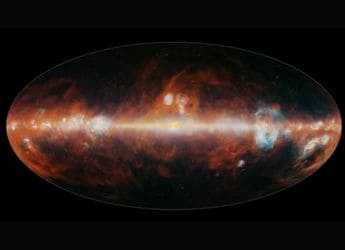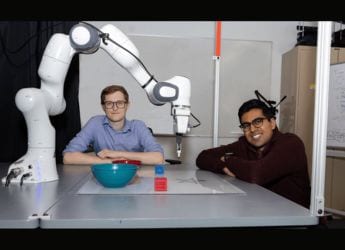- Home
- Science
- Science News
- Atomic TV Broadcasts Live Video Using Lasers and Cloud Of Large Sized Atoms
Atomic TV Broadcasts Live Video Using Lasers and Cloud Of Large-Sized Atoms
Atom-based communication systems are believed to be smaller and can tolerate more noise than conventional electronics.

Photo Credit: NIST
The atoms, used in the device, are prepared in high-energy Rydberg states
Demonstrating that a cloud of atoms can be used as a receiver to pick up video transmission, researchers have developed an atomic television. The television uses atom clouds and lasers to carry video signal that meets the traditional resolution standard. Atom-based communication systems are believed to be smaller and can tolerate more noise than conventional electronics. The atoms, used in the device, are prepared in high-energy Rydberg states, which are unusually sensitive to electromagnetic fields including radio signals.
The team from the National Institute of Standards and Technology (NIST), US, prepared gaseous rubidium atoms in Rydberg states in a glass container using two different colour lasers. In order to receive signals, a stable radio signal is applied to the atoms-filled glass container. Here, the energy shifts in the Rydberg atoms that modulate the carrier signal can be detected by the team.
Following this, the modulated output is fed to television after which an analogue-to-digital converter changes the signals into a video graphics array format for display. When a live video signal or game is to be displayed, the input is sent from a video camera to modulate the original carrier signal. This signal is then fed to a horn antenna which directs the transmission to the atoms.
The original signal carrier is used as a reference and the final video output, detected through the atoms, is compared with it to evaluate the system.“We figured out how to stream and receive videos through the Rydberg atom sensors. Now we are doing video streaming and quantum gaming, streaming video games through the atoms. We basically encoded the video game onto a signal and detected it with the atoms. The output is fed directly into the TV,” said Chris Holloway, project leader and author of the study.
In the study, published in AVS Quantum Science, the team studied the laser beam powers, sizes, and detection methods so that video can be received in standard definition format by the atoms. The size of the laser beam affects the average time the atoms remain in the interaction zone of the laser. The time here is inversely related to the receiver's bandwidth which means that more data is produced using a smaller beam and shorter time.
Get your daily dose of tech news, reviews, and insights, in under 80 characters on Gadgets 360 Turbo. Connect with fellow tech lovers on our Forum. Follow us on X, Facebook, WhatsApp, Threads and Google News for instant updates. Catch all the action on our YouTube channel.
- Samsung Galaxy Unpacked 2025
- ChatGPT
- Redmi Note 14 Pro+
- iPhone 16
- Apple Vision Pro
- Oneplus 12
- OnePlus Nord CE 3 Lite 5G
- iPhone 13
- Xiaomi 14 Pro
- Oppo Find N3
- Tecno Spark Go (2023)
- Realme V30
- Best Phones Under 25000
- Samsung Galaxy S24 Series
- Cryptocurrency
- iQoo 12
- Samsung Galaxy S24 Ultra
- Giottus
- Samsung Galaxy Z Flip 5
- Apple 'Scary Fast'
- Housefull 5
- GoPro Hero 12 Black Review
- Invincible Season 2
- JioGlass
- HD Ready TV
- Laptop Under 50000
- Smartwatch Under 10000
- Latest Mobile Phones
- Compare Phones
- Huawei Nova 15
- Huawei Nova 15 Pro
- Huawei Nova 15 Ultra
- OnePlus 15R
- Realme Narzo 90x 5G
- Realme Narzo 90 5G
- Vivo S50 Pro Mini
- Vivo S50
- Asus ProArt P16
- MacBook Pro 14-inch (M5, 2025)
- Huawei MatePad 11.5 (2026)
- OnePlus Pad Go 2 (5G)
- OnePlus Watch Lite
- Just Corseca Skywatch Pro
- Acerpure Nitro Z Series 100-inch QLED TV
- Samsung 43 Inch LED Ultra HD (4K) Smart TV (UA43UE81AFULXL)
- Asus ROG Ally
- Nintendo Switch Lite
- Haier 1.6 Ton 5 Star Inverter Split AC (HSU19G-MZAID5BN-INV)
- Haier 1.6 Ton 5 Star Inverter Split AC (HSU19G-MZAIM5BN-INV)












